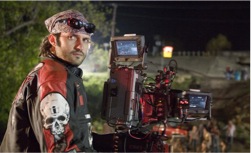Play-Doh, Today
Robert Rodriguez. He makes movies. Heard of him? Desperado? Planet Terror? Sin City? Once Upon a Time in Mexico? Machete? Spy Kids? No?
 Rodriguez became known in the mid-1990s for El Mariachi, a largely Spanish-language action flick produced for only $7,000. He's since settled down into Hollywood "moguldom," but even so retains his independent spirit and, like many filmmakers of his generation, an absolute disdain for old-school techniques and technologies. Rodriguez was one of the first devotees of digital moviemaking. Way back in 1996, this filmmaker had already quit using film. In his book Rebel Without a Crew, he puts it rather succinctly:
Rodriguez became known in the mid-1990s for El Mariachi, a largely Spanish-language action flick produced for only $7,000. He's since settled down into Hollywood "moguldom," but even so retains his independent spirit and, like many filmmakers of his generation, an absolute disdain for old-school techniques and technologies. Rodriguez was one of the first devotees of digital moviemaking. Way back in 1996, this filmmaker had already quit using film. In his book Rebel Without a Crew, he puts it rather succinctly:
Some people say that cutting on film itself rather than video or computer gives the filmmaker a much closer relationship to the film by allowing hand manipulation of the images, as opposed to pushing electronic buttons to cut your film. If you like the sound of that, do yourself a favor and take some film home at night and fondle it all you want.
Celluloid was a grossly antiquated mechanism before the 21st century even dawned, and that's well before off-the-shelf applications like Adobe After Effects and Final Cut Pro allowed anyone with some training, a good eye, and a computer to create and edit their own special effects-laden masterpiece from the comfort of their homes. Yet even now, in 2011, many in Hollywood insist on using film to make their movies...film that, in most cases, is then converted to digital video for distribution, as few modern theaters project on film any more. Psychologically, people seem to get nervous when it comes to working in a wholly digital domain.
As living things, we are heavily defined by the ways in which we're able to influence the world around us. Our hands. Our tools. Take those things away, even if you're still able to do everything (and more!) that you used to be able to do, and it gets weird.
So much of manufacturing and product design still depends on that brick of clay, cut and shaped and formed into a car, or a camera, or a toaster oven. I don't mean to disparage clay, or even the "feel" of designing a product with your hands — the tactile experience can still be a part of it. But is it necessary? Is it relevant? Do we need it?
 More and more we are seeing creators, artists, and visionaries abandoning methods that hold them back and embracing new, digital technologies. Has this destroyed oil painting as an art form? No. New things rarely erode old ones; they simply offer greater potential for creation. Today, just as many famous directors shoot on film because it "feels" correct, many manufacturers stick with the old approaches because they're used to them.
More and more we are seeing creators, artists, and visionaries abandoning methods that hold them back and embracing new, digital technologies. Has this destroyed oil painting as an art form? No. New things rarely erode old ones; they simply offer greater potential for creation. Today, just as many famous directors shoot on film because it "feels" correct, many manufacturers stick with the old approaches because they're used to them.
Product design, engineering, manufacturing; these disciplines are art just as much as the oil paintings and sculptures we view in galleries. Ultimately something real and powerful springs from raw materials. And in that way, manufacturing is not changing. However we approach it, the final product is still something physical and tangible that we can use. I sympathize with the concern that new digital manufacturing approaches will subvert the old ones and put people out of work, but reality and history tells us this does not actually happen. It's simply based on fear, fear of new tools.
For the athletic shoe designer who does not fully see how modeling and simulation could transform his or her creations: imagine developing a shoe digitally, every part, and putting every possible variant of every foot through every activity, ten thousand times, then using the results to tweak and tune the shoe until it's perfect. No amount of real world prototyping could do that, but digital M&S could.
For the toaster oven designer who sees what they do as a consumer product with no particular need to optimize or perfect: imagine testing the thermals of your creation against every Hot Pocket, every type of bread, every frozen dinner, and using the results to not just ensure even cooking, but reduced energy and increased safety. If a simple change that you'd never have seen without M&S tells you that people will no longer burn themselves when toasting a Pop-Tart, or that just an ounce of coal that would otherwise have been burned is saved, is that not worth the new approach?
Can we continue to design and manufacture, maybe for years, without adopting M&S? Sure. We can continue making movies on film, too. But it costs more. It takes more time. It opens the door to errors that we could avoid. Just because we're used to the feel of things, or to doing things with our hands, does not mean that we can't incorporate new approaches that promise a vast horizon of greater potential simply impossible without them.










